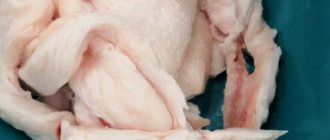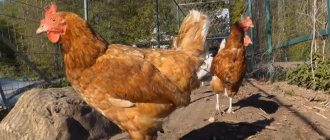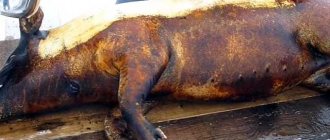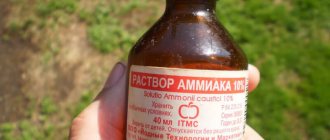Today we will talk about such an important product as salted lard. We will learn how to choose lard for salting, how to salt lard at home correctly so that it is tasty and how to store this product, beloved by many.
Lard, as a national Ukrainian product, became known to the world in the 18th century, but even before that time it was popular on the menu of Western Slavs (Poles), among Hungarians, Turks, and salted lard was served in restaurants in Germany and France.
Lard of various varieties and types remains in trend: it is salted, smoked, and heat-treated. The most popular is salted lard (lard). Well salted, it is suitable for preparing carpaccio, cold cuts, sandwiches, and is suitable as an additional dish with borscht, green garlic and pampushki. The secret to perfect taste is in proper salting and selection of lard removed from a certain part of the carcass.
How to choose lard for salting: tips
Isolation and disassembly of lard is done manually - the pork carcass is hung on a hook and the fat layer is cut off along the fat layer in one strip along with the cheek, then the lard is cut into the back and side. Correctly selected lard for salting after processing acquires a delicate structure, specific aroma and taste.
What type of lard is there?
1. Back: soft, uniform fatty subcutaneous layer without meat. The shoulder part is hard, narrowed towards the edge, the loin is a thick lard of the same thickness along the entire edge, soft, melting in the mouth after salting. The fat of the back and shoulder blades can be salted using dry, wet, or a combined method. The most popular and delicious lard without a meat layer is a regular on the Ukrainian menu.
2. Barrel: a small layer of heterogeneous fat is covered on top with a thin layer of light-colored meat. This type is suitable for salting by any method, even salting “by eye”, where control of the amount of salt is not required - fat weakly absorbs salt, and highly salted meat harmoniously complements the bland lard.
3. Cheek: upper and lower layers of fat with a thick skin, between which there is a thin layer of meat. The fat layer is slightly shiny, has an uneven consistency, the meat is shiny, and has a thickness of no more than 1-2 cm. The cheek is suitable for the wet salting method, and marinades should be chosen carefully: a large amount of salt will make the finished product tough, salty and tasteless.
4. Neck part: harsh lard with thick skin is not suitable for salting. The texture is dense and the fat is difficult to cut with a knife. It is good for preparing corned beef with long-term heat treatment or for dry salting followed by hot smoking.
5. Kryzhok (lumbar part of a pork carcass), ham: soft, delicate structure, sometimes porous and loose (back part), slightly “stretches” when biting. Several layers of meat and a layered top are allowed. Ideal for pickling in any way, but the amount of salt should be kept under control.
6. Underbelly (belly part of a pork carcass): thin lard with wide layers of dark red meat fibers. Thin strips of subcutaneous fat alternate with thin layers of meat, so when salting, the amount of salt should be reduced by 10%, otherwise the salted lard will be tough and tasteless. This part of the carcass is suitable for making bacon, prosciutto (salted lard is smoked and dried to give it a beautiful texture).
7. Internal fat (sdor): the fat layer removed from the lower part of the pork carcass has an oily consistency and a specific aroma. Suitable for salting in a complex marinade followed by thermal processing into lard.
8. Trimmings: third grade fat, removed from different parts of the pork carcass. Suitable for dry or wet salting, but due to the heterogeneity of the pieces, it is not recommended to salt such lard.
You may also be interested in the recipe: How to salt red fish at home
What you need to know
I buy it only at the market, this is the best option, since there is also a large selection of village homemade lard. In the village, on private farms, pigs are raised on natural feed, so it is the healthiest.
It's even better to buy from sellers you know well. They usually remember regular customers and try to offer them the best.
An alternative is to buy from friends who are trustworthy in terms of the fact that the animal was not fed dangerous substances such as meat-and-bone meal and the like, that the pig was not sick and was not injected with medicine.
The softest part of the pig is the back, followed by the flank and the brisket, the brisket has more meat, so it is tougher. Thick lard will be soft.
White lard without any layers is very useful for women and children, and it will also appeal to older people, since this kind of lard is the softest.
How to salt lard?
There are two ways of salting:
1. Simple, when only salt or its concentrated solution is used. 2. Complex, in which they use a mixture of several types of table salt with nitrites, sugar, seasonings (garlic, bay leaf, allspice).
There are three types of salting: dry, wet, combined (mixed). Dry is suitable for long-term storage of lard, wet is suitable for fat cut from the back of the carcass, combined is ideal for loin, brisket, fat removed from the shank.
It is better to salt lard when it is chilled or slightly frozen, then the structure of the fibers and the texture of the fat layer will be preserved, and the salted lard will not be loose.
Wet method of salting lard
Will need
- 1 kg of back fat (up to 5 cm high);
- 2 liters of brine (saturated salt solution: 150-200 g of table salt per liter of water);
- 100 g garlic (cut the cloves into slices);
- 25 g allspice;
- 3-5 bay leaves.
Preparation
- Cut the lard into longitudinal pieces 5 cm thick and place in a wooden container or enamel container. Place spices between the pieces of bacon: bay leaf, pepper, garlic. Pour in the brine so that the lard is completely covered with the marinade, cover with a lid.
- Leave the container at a temperature of +15 degrees for 24 hours, then transfer it to the cold for 3 weeks. To store the lard, remove it from the brine, dry it, wrap it in gauze or clean cotton cloth, and leave it in the refrigerator or basement. The shelf life of wet salted lard is 8 months at a temperature not exceeding +15 degrees.
Dry method
Ingredients
- 1 kg of lard of any kind;
- 1 kg of table salt (without additives);
- 25 g ground black pepper.
Preparation
Mix salt and pepper, grate the lard on all sides, then pour a 1 cm layer of salt and pepper onto the bottom of the container, lay out the lard, sprinkle with salt. The product will be ready in 7 days. The shelf life of salted lard at temperatures up to +15 degrees is one and a half years.
Complex (industrial combined method)
- 5 kg of lard (ham, back, side);
- 50 liters of water;
- 8 kg of coarse salt without sorbents;
- 7 kg sugar;
- 0.25 g nitrite.
1. Prepare a brine from 7.5 kg of salt, sugar, nitrite, water: mix the ingredients, bring to a temperature of 90 degrees, cool to a temperature of 35-40 degrees, strain. 2. Using a syringe and needle, inject around the perimeter of the fat at the rate of 5 ml of saline solution per 5 square meters. cm (the depth of piercing with a needle is 1-4 cm depending on the thickness of the lard). 3. Rub the lard with salt on all sides, put under a press for 12 hours. 4. Pour brine into the container where the lard was under the press, after 3 days, remove the lard and hang in a cool, dry room for maturation, the product is completely ready in 2-3 days.
Salted lard acquires an elastic consistency, a pink tint to the meat, and a glossy shine.
The shelf life (due to the use of nitrite) increases to 3 years.
Complex household method
- 1 kg of lard with meat layers;
- 2 liters of water;
- 1 g of saltpeter;
- 250 g salt;
- 10 cloves of garlic;
- 100 g sugar;
- 10 g allspice;
- 3 bay leaves.
1. Prepare a complex marinade: mix salt, sugar, water in a container, put on fire, add garlic, bay leaf, pepper, bring to a temperature of 90 degrees. 2. Cool the marinade, add saltpeter, stir. 3. Place lard in a wooden or glass container (cut into pieces 5x5x5 cm), pour in the marinade, and close with a lid. Keep in the marinade for 2-3 weeks. 4. Remove the lard from the marinade, dry it, put it in a wooden box, alternating layers of lard with layers of table salt. Store for 1.5 years.
Salted lard “Spicy”:
1. To prepare salted bacon “Picant”, you need to prepare a salt solution (1 liter of water + 50 g of salt), inject with a needle around the perimeter of the entire piece of lard. 2. Prepare a 5% gelatin solution (100 ml water + 5 g gelatin), bring to a temperature of 65 ° C, add 5 g hot pepper, stir. 3. Dip lard into the solution and leave for a day. Then remove, lightly sprinkle with salt (at the rate of 20 g of salt per 1 kg), leave in a container for a week at a temperature of 18-22 ° C. The shelf life of salted bacon “Pikantny” is 7 days after salting.
Salted lard with spices
Dry salting of lard with spices is a fashionable trend in the field of salting, in which you can use any combination of spices, for example, for Hungarian salting you will need paprika, hot ground pepper, salt and oregano; for Indian-style salting of lard - turmeric, ginger, cumin, ground black pepper and chopped bay leaf.
Calculation of salt for 1 kg of lard with thin layers of meat is 100-150 g, spices should be adjusted to taste.
Documentation
When looking closely at a particular piece of lard, you should ask the seller about documents confirming that the product meets the standards of the sanitary epidemiological station. It would also be useful to make sure there is a seal on a piece of lard or carcass. As a rule, this should not be a problem in stores, since upon receiving the goods the availability of the relevant documents is checked. However, not everyone on the market can provide it, so it is better to refuse to buy such lard, since it may turn out that the animal was sick.
How to store lard?
Storage conditions for salted lard depend on the salting method:
- Dry salted lard is stored in wooden chests or glass jars in a dark room at temperatures up to +15 degrees throughout the year;
- Wet-salted lard is removed from the brine/marinade, dried, wrapped in gauze or dry cloth, hung and left in the refrigerator or basement for up to 8 months;
- Salted lard with nitrite added to marinades or pickling mixtures can be stored in a cool room for three years;
- Lard salted with spices can be stored for up to 30 days in a cool place, protected from sunlight.
To prevent salted lard from turning yellow and aging during storage, the container must be covered with an airtight lid
After oxygen gets inside the jar or chest, lard should be used up as soon as possible: the oxidation process will quickly make the product tasteless.
An iron (slate) nail placed in a glass jar with salted lard extends the shelf life, but after the container is depressurized, its properties completely disappear - the lard begins to turn yellow and deteriorate under the influence of oxygen.
Lard is stored in a dark, cool place at a temperature no higher than +15 degrees; if the specified conditions are met, salted lard retains its taste and aesthetic properties.
If you read the article to the end, then we can say that you have become an expert on lard) And now you know exactly how to pickle lard, how to store it and how to choose the right lard when buying!
Enjoy your meal!
0
Author of the publication
offline 26 minutes
How long does it take to cook lard?
A piece of lard weighing half a kilogram should be boiled for 10 - 15 minutes. Lard is placed in boiling water. The amount of water in the pan should be enough so that the lard is completely covered, but not excessive so that the lard “floats”. You should also add salt, bay leaf and allspice to the water.
Interesting materials:
How to add full-format videos to stories? How to get to the Baltic Station? How to get to the business center by metro? How to get to Domodedovo from Kyiv? How to get to Georgia? How to get to Krasnogorsk? How to get to Cuba from Moscow? How to get to mega white dacha? How to get to Sheremetyevo from Planernaya? How to get from Adler to Gagra by train?
Lard in brine
We'll tell you how to pickle lard in brine. The second name for this recipe is sponder. Take a piece of meat - cheek, brisket or chuck. You will need the most aromatic spices - the richer the marinade, the tastier the lard will be.
Ingredients
- lard – 1 kilogram;
- paprika – 1 tablespoon;
- ground pepper mixture – 1 tablespoon;
- ground cardamom - on the tip of a knife;
- bay leaf – 1-2 pieces;
- allspice peas – 1-2 pieces;
- fennel – ¼ tablespoon;
- salt – 7 tablespoons;
- water – 2 liters.
Preparation
Pour water into a wide saucepan and bring to a boil. Add salt and spices to boiling water. Cut the lard into pieces convenient for storing, dip into the marinade, reduce the heat to low and after boiling, cook for 45 minutes. During the process, periodically turn the lard over and make sure that it is in the brine all the time, adding water if necessary.
Turn off and leave until completely cool. Remove the lard, pat dry with paper towels and freeze. If you store the finished product in the refrigerator, grate each piece with grated garlic, wrap in parchment paper and place in a bowl.
What affects the quality and taste of lard?
Butchers, farmers and chefs believe that the following factors influence the taste and quality of lard:
- Breed: in our country, Mirgorod pigs are raised for lard.
- Age: the greasy layer of young piglets contains a fair amount of olein, so it is loose and grainy, and the product obtained from old animals has a yellow tint and high density.
- Gender: a product obtained from a hog, according to gourmets, is tastier than lard from pigs.
- Feed: in fact, it is what the piglets ate that determines the taste and quality of the lard.
Of course, knowledge of what affects the quality and taste of the product will help you navigate when purchasing. But it is much easier to choose lard based on specific characteristics.
There are only two days in April: when to sow tomatoes for seedlings to get a harvest
Scientists from Michurinsky Agrarian University have developed a robotic gardener for greenhouses
It's over: Meghan and Harry stop using the royal logo
Lard in onion skins
If you don’t have a smokehouse, but want aromatic golden lard, try salting it hot. A piece with meat sprout, 7-10 centimeters thick - cheek, brisket or undercut - is suitable.
Ingredients
- lard – 1 kilogram;
- bay leaf – 2-3 pieces;
- allspice peas – 2-3 pieces;
- salt – 5 tablespoons;
- onion peel - 3 large handfuls;
- garlic – 4-5 cloves;
- water – 2 liters.
Preparation
Rinse the onion skins thoroughly under running water, then add water and bring to a boil over high heat. Reduce the temperature, add salt and spices, continue cooking for 30 minutes over low heat until the lard brine begins to darken. Reduce the temperature to low, simmer for another 20 minutes, then turn off, leave until dark brown and strain.
Cut the lard into pieces convenient for putting in a pan, add brine, bring to a boil and cook for 20 minutes. Turn off the stove and leave the lard to infuse in the marinade, salt the workpiece for 8-10 hours in the refrigerator.
Remove the lard from the liquid and dry with paper towels. Chop the garlic, grate the pieces, put them in a bowl and put them in the freezer for 5-6 hours.











